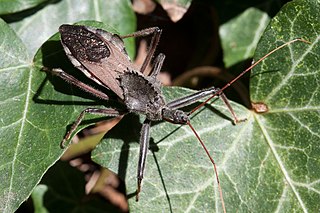
Cabbage, comprising several cultivars of Brassica oleracea, is a leafy green, red (purple), or white biennial plant grown as an annual vegetable crop for its dense-leaved heads. It is descended from the wild cabbage, and belongs to the "cole crops" or brassicas, meaning it is closely related to broccoli and cauliflower ; Brussels sprouts ; and Savoy cabbage.

Broccoli is an edible green plant in the cabbage family whose large flowering head, stalk and small associated leaves are eaten as a vegetable. Broccoli is classified in the Italica cultivar group of the species Brassica oleracea. Broccoli has large flower heads, or florets, usually dark green, arranged in a tree-like structure branching out from a thick stalk, which is usually light green. The mass of flower heads is surrounded by leaves. Broccoli resembles cauliflower, which is a different but closely related cultivar group of the same Brassica species.

Pentatomidae is a family of insects belonging to the order Hemiptera, generally called shield bugs or stink bugs. Pentatomidae is the largest family in the superfamily Pentatomoidea, and contains around 900 genera and over 4700 species. As hemipterans, the pentatomids have piercing sucking mouthparts, and most are phytophagous, including several species which are severe pests on agricultural crops. However, some species, particularly in the subfamily Asopinae, are predatory and may be considered beneficial.

Chinese cabbage is either of two cultivar groups of leaf vegetables often used in Chinese cuisine: the Pekinensis Group and the Chinensis Group.

Arilus cristatus, also known as the North American wheel bug or simply wheel bug, is a species of large assassin bug in the family Reduviidae and the only species of wheel bug found in the United States. It is one of the largest terrestrial true bugs in North America, reaching up to 1.5 inches (38 mm) in length in its adult stage. It is sexually dimorphic, in that males are somewhat smaller than the females. A characteristic structure is the wheel-shaped pronotal armor. North American wheel bugs prey on caterpillars and beetles, such as Japanese beetles, the cabbage worm, orange dogs, tent caterpillars, and the Mexican bean beetle, all of which they pierce with their beak to inject salivary fluids that dissolve soft tissue. The North American wheel bug is most active in daylight, but may engage in predatory behaviors at night in areas illuminated by lights. Because most of its prey are pests, the wheel bug is considered beneficial.

The Anthomyiidae are a large and diverse family of Muscoidea flies. Most look rather like small houseflies. Most species are drab grey to black. Many Pegomya are yellow, and some members of the genera Anthomyia and Eutrichota are patterned in black-and-white or black-and-silvery-grey. Most are difficult to identify, apart from a few groups such as the kelp flies that are conspicuous on beaches.

The European paper wasp is one of the most common and well-known species of social wasps in the genus Polistes. Its diet is more diverse than those of most Polistes species—many genera of insects versus mainly caterpillars in other Polistes—giving it superior survivability compared to other wasp species during a shortage of resources.

Napa cabbage is a type of Chinese cabbage originating near the Beijing region of China that is widely used in East Asian cuisine. Since the 20th century, it has also become a widespread crop in Europe, the Americas, and Australia. In much of the world, it is referred to as "Chinese cabbage". In Australia, it is sometimes referred to as "wombok".

Eurydema ornata is a species of shield bug in the family Pentatomidae.

Eurydema oleracea is a species of shield bug in the family Pentatomidae and is commonly known as the rape bug, the crucifer shield bug, the cabbage bug or the brassica bug.

Crocidolomia pavonana is a moth of the family Crambidae. Its caterpillar is a crop pest and is known as the croci or the cabbage cluster caterpillar. This moth is found in Africa and Asia, its range extending from South Africa through India to the Pacific Ocean, including Australia. The wingspan is about 25 mm (1 in). The larvae feed on Brassicaceae species and are considered an agricultural pest on cabbages. The species was first described by Johan Christian Fabricius in 1794.
In the 10th edition of Systema Naturae, Carl Linnaeus classified the arthropods, including insects, arachnids and crustaceans, among his class "Insecta". True bugs and thrips were brought together under the name Hemiptera.

Eurydema ventralis is a shield bug of the family Pentatomidae, subfamily Pentatominae. The species was first described by Friedrich August Rudolph Kolenati in 1846.

Eurydema is a genus of mostly Palaearctic shield bugs in the family Pentatomidae.
Clytiomya continua is a European species of fly in the family Tachinidae. Hosts for the parasitoid larvae include Coreus marginatus orientalis, Eurygaster testudinaria, Eurydema gebleri, Eurydema dominulus, Graphosoma rubrolineatum, Homalogonia confusa, and Dolycoris baccarum. Larval development takes six to eleven days.
Balanococcus cordylinidis, the cabbage tree mealybug, is a species of insect in the family Pseudococcidae.













